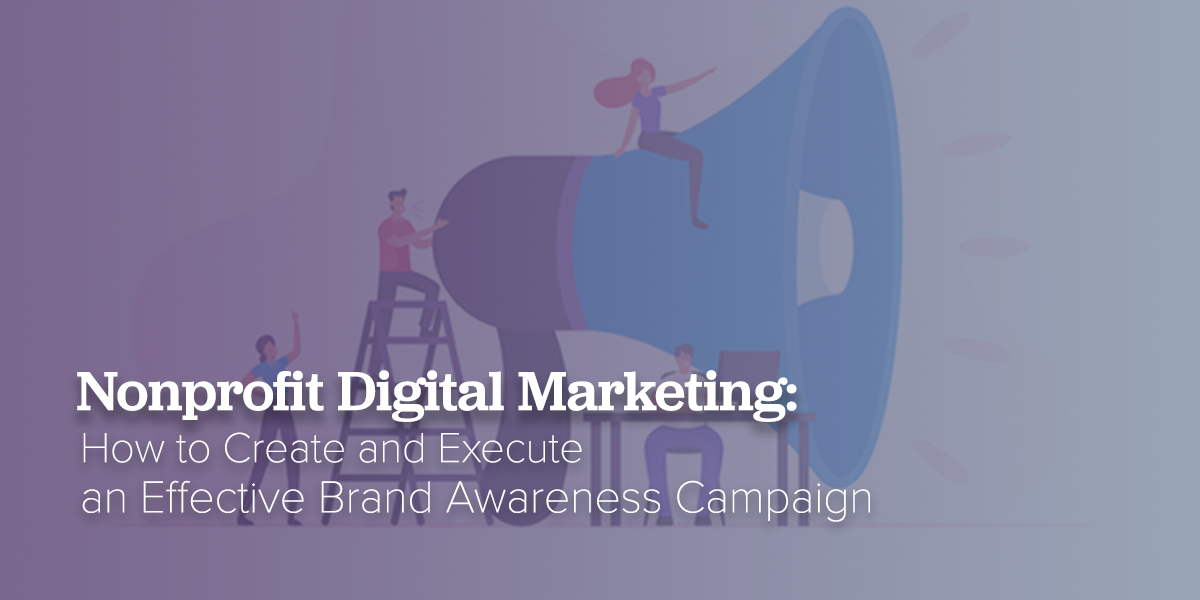Nonprofit Digital Marketing: How to Create and Execute an Effective Brand Awareness Campaign
Ilia Jones | January 2022

Brand awareness can seem like a nebulous concept. What does it mean to be aware of a brand? And why does it matter?
What is Brand Awareness and Why is it Important for Nonprofits
As a nonprofit, the visibility and recognition of your target audience are no less critical than for other for-profit businesses. Brand awareness is the marketing term for that visibility and recognition. It can be a simple as your audience recognizing your logo or brand colors when they see them. Think of the iconic Nike swoosh.
Or brand awareness can be a little less defined, such as the consciousness of your nonprofit’s cause. Because if your audience recognizes the problem you are trying to solve, and you’ve differentiated yourself in the sphere, they will think of you too.
Most other marketing efforts have goals. These may include increased sales, subscriptions, services rendered, or donations in the nonprofit sector. Brand awareness is less tangible and concrete and is, therefore, harder to measure. However, a brand awareness campaign can help you build trust and gain donors, volunteers, and partners.
How to Create a Brand Awareness Campaign
Creating a brand awareness campaign will require you to do a little digging into your current online visibility and engagement. There are four phases to creating an effective awareness campaign, and it’s essential that you take the time to work through each one.
Audit Your Current Online Presence
The first phase of your brand awareness campaign is the assessment of where your nonprofit currently has an online presence and what that presence looks like.
- Review the social media channels where you are actively posting.
- Take a close look at your search rankings, preferably on more than one search engine.
- Analyze your email campaign performance for open and click rates.
- Assess any other online activity, such as partnerships, professional organizations, or sponsorships.
Once you have audited every point of visibility for your nonprofit online, compile this data and create a baseline that you can measure success against.
Determine Where Your Audience is Online
Hint: Your audience might not be where you think they are.
Consider your target audience and their key demographics, then do some digging to find out where they actually hang out online. For example, 15 years ago, Facebook was filled with Millennials sharing photos of their avocado toast. Today, however, it’s filed with the parents of those Millennials who joined to ogle photos of their grandchildren.
Research the social media channels and platforms you’re currently using. And find out whether the audience you’re targeting is there or whether you need to start pointing your marketing efforts in a different direction.
Don’t know where to start? You may need to begin with defining your target audience and segmenting them into marketing personas. This will also give you a head start for personalizing your marketing.
Use or Create a Brand Style Guide
As we’ve mentioned, your logo or brand colors can be strong identifiers for your audience. One way to ensure a robust and consistent brand presence is by creating a brand style guide.
A brand style guide includes rules for the usage of your nonprofit’s:
- Logo
- Brand colors
- Typeface
- Voice
- Image style
All of these elements, and more, come together to create a guide for all your staff. It will ensure that any communication, image, social post, or email campaign sounds like it’s from one unified organization. The consistency made possible by a brand style guide will make raising your nonprofit’s brand awareness a snap!
Determine Your Channels and Content
In phases 1 and 2, you figured out where you are and where your audience is online. In the last phase of creating your brand awareness campaign, it’s time to bridge that gap. And, with your new brand guide, your nonprofit will be instantly recognizable!
Channels
Review the current social media channels and places where you are currently active and find the overlap with where your target audience, or personas, spend their time. Then create a plan to focus your efforts on the overlap and expand into new territory as needed. Think of it as a Venn diagram, if that’s helpful.
For example, you’re currently posting on Facebook, Twitter, and Instagram. But your target audience is on Instagram, Twitter, and TikTok. Keep your Instagram and Twitter campaigns. And minimize your Facebook efforts to maintain a business or fundraising page and explore how to bring your brand to TikTok!
Content
Once you’ve determined which channels to focus your efforts on, it’s time to brainstorm your content. Brand awareness content doesn’t need to have a goal of fundraising or gaining new volunteers. It exists solely to explain who you are and why you do what you do.
This content should be inspiring, authentic, and designed with robust branding so that your brand becomes second nature to your audience. Ideally, this content will also engage for your audience and encourage interaction and sharing.
And, to reach the largest audience possible, it’s essential to represent the cultural diversity of your organization in all your content and promotions.
The Most Effective Digital Marketing for Brand Awareness
The most effective digital marketing for any brand has all or some of the following hallmarks:
- It differentiates your brand
- It’s relatable
- It inspires emotion
- It showcases your organization as a thought leader
Remember, the content you’re creating for your brand awareness campaign isn’t trying to sell anyone anything other than who you are as a nonprofit organization. As you’re building your reputation, remember that each piece of content or social media post should reflect one of these characteristics.
Social Media
Using social media as a tool to increase your reach and brand awareness is an obvious choice. Not only can you create posts that will be seen by many people (without needing their email address to reach them), but you can also target those posts.
Using hashtags allows you to reach a greater audience than may follow your profile. Social media is also “social,” so people happily share images and content that they find interesting, inspiring, or entertaining. Follow best practices for whichever platform you’re using to get your content out to your audience and as many people as possible.
Organic Search
A strategy for search and SEO is essential for any organization. Consider SEO keywords, both long-tail and short, or even featured snippets, to inform your content marketing strategy and drive traffic to your website. By consistently using SEO keywords in your social media posts, blogs, and other content, you can help improve the impact on your organic search.
Content Marketing
Content marketing is a blanket term for any marketing effort that consists of long-form content such as blog posts, white papers, ebooks, and other free content as well as videos. No matter which of these formats you are working with, the most important technique is storytelling. Using these formats to tell a story helps you to share what your nonprofit does, why, and describe your cause .
Blog posts help to boost your SEO and provide a place for a detailed look into the many aspects of what your organization does. White papers and ebooks are excellent vehicles for thought leadership. And videos all you to combine language, visuals, and a heartstring-pulling score to tell emotional stories that will inspire your audience.
Backlinks
Search engines use crawlers to identify and map all of the pages on your website. But they also find links to your website on other sites. Link building is the curation of links back to your website from other places on the internet, also known as backlinks. Backlinks and link building should be an essential part of your SEO strategy, as they can help your site rank higher in search results.

